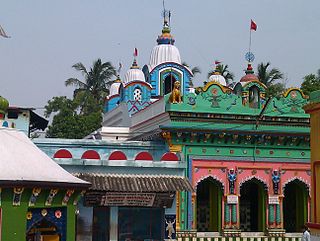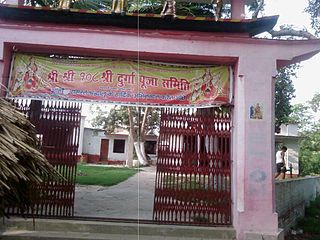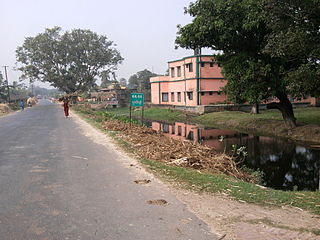
Durga Puja, also known as Durgotsava or Sharodotsava, is an annual Hindu festival originating in the Indian subcontinent which reveres and pays homage to the Hindu goddess Durga and is also celebrated because of Durga's victory over Mahishasur. It is celebrated all over the world by the Hindu Bengali community but it is particularly popular and traditionally celebrated in the Indian states of West Bengal, Bihar, Assam, Tripura, Odisha, Jharkhand, Uttar Pradesh and the country of Bangladesh. The festival is observed in the Indian calendar month of Ashwin, which corresponds to September–October in the Gregorian calendar. Durga Puja is a ten-day festival, of which the last five are of the most significance. The puja is performed in homes and public, the latter featuring a temporary stage and structural decorations. The festival is also marked by scripture recitations, performance arts, revelry, gift-giving, family visits, feasting, and public processions. Durga Puja is an important festival in the Shaktism tradition of Hinduism. Durga Puja in Kolkata has been inscribed on the Intangible cultural heritage list of UNESCO in December of 2021.

Goramansingh also known as Gauramansingh is a small village in the Darbhanga district of Bihar, India. It is located approximately 62 kilometers east of Darbhanga and 12 kilometers east from its subdivisional headquarters of Biraul on the bank of the Kamala River in Bihar.

Balasore or Baleswara is a city in the state of Odisha, about 194 kilometres (121 mi) north of the state capital Bhubaneswar and 300 kilometres (186 mi) from Kolkata, in eastern India. It is the largest town of northern Odisha and the administrative headquarters of Balasore district. It is best known for Chandipur beach. It is also called 'missile city'. The Indian Ballistic Missile Defence Programme's Integrated Test Range is located 18 km south of Balasore.

The Maa Sarala Temple is a Hindu temple in the district of Jagatsinghpur, Odisha, India. It is one of the eight most famous Shakta shrines of Odisha.
Panchobh is a village in Darbhanga District, Bihar, India. It is one of the largest villages in the Mithila Region by area and population. The town of Laheriasarai, the administrative headquarters of Darbhanga district, is eight kilometers to the east. The name of the village comes from the ancestor Sri Panchu Baba, who established the village.
Bharri is a village situated in the northeastern Bihar district of Katihar. It is under the constituency of Kadwa. Its sub-divisional office is at Barsoi and Block Development Officer is at Kumhari. This village has a hospital, a post office and also a panchayat office which is headed by people elected member called Mukhiya and a sarpanch. Surendra Nath Thakur from Thakur family has served as mukhiya of this village for 23 years. Present mukhiya is Vinodanand Shah. There is a telephone communication to district headquarters Katihar and as well as sub-divisional office Barsoi and also have electricity and road communication.
Jajuara, also written Jajuar and Yajuar, is the largest village in the Muzaffarpur district of Bihar in India, and the second-largest village in Bihar.
Bangaon is an ancient northern Indian village situated in the Saharsa district of Bihar. Some historians believe that 'Apannigam' referred in Buddhistic literature is Bangaon. Bangaon is part of Kahra Block of the district. Some of the neighbouring places include Bariahi, Bangaon, Chainpur, Mahishi and Bihar (north). Bangaon is divided into three panchayats namely Bangaon North, Bangaon South and Bangaon East.

Navaratri is an annual Hindu festival observed in the honour of the goddess Durga. It spans over nine nights, first in the month of Chaitra, and again in the month of Sharada. It is observed for different reasons and celebrated differently in various parts of the Hindu Indian cultural sphere.
Patan Devi, also called Maa Patneshwari, is the oldest and one of the most sacred temples of Patna, Bihar. It is regarded as one of the 51 Siddha Shakti Pithas in India. According to Puranic legends, the 'right thigh' of the corpse of Devi Sati had fallen here when it was chopped off by Lord Vishnu with his 'Sudarshan Chakra'. The ancient temple, originally called Maa Sarvanand Kari Patneshwari, is believed to be the abode of the goddess Durga.

Durgapur is a village located in Angul district, in the Indian state of Odisha.

Bhoj Pandaul or Bhojparaul is a village situated around 15 km from Madhubani, district headquarters of Madhubani district, Bihar state, India.

Dullipatti is a village, situated in Madhubani district of Bihar, near the Nepal international border. National Highway 105 passes through this village and is 6 kilometers away from Jainagar, sub-division.
Manik Chowk is a village in the Indian state of Bihar.
Mortar is a village in the Garhpura block of Begusarai district in the Indian state of Bihar about 32.5 km (20.2 mi) north of district capital, Begusarai. The 2011 census gives its population as 1,817. It comes under Malipur Panchayat and under post office Malipur.

Naromurar is a Village in Warisaliganj Tehsil, located 10 km (6.2 mi) from National Highway 31 and 8 km (5.0 mi) from State Highway 59, making it the only village of the area well connected to both Nawada and Nalanda districts of Bihar.
Literally the word Nar means water and Murar means Lord Krishna who appeared as the 8th avatara of Lord Vishnu in Dvapara Yuga as mentioned in Garuda Purana, that is the word Naromurar means the house of lord Vishnu -Kshirsagar.
Naromurar is a village of great traditions. It is one of the ancient villages of India having a four hundred year older Thakur Wadi dedicated to Maryada Purushottam Ram and Lord Shiva.
Along with the Rajkiyakrit Madhya Vidyalay having established in 1920 AD, 27 years before the freedom of India, a Janta Pustakalay the Public Library is also started in the year of 1956 AD which was inaugurated by the Education Minister of Bihar during the time of Krishna Singh.
Khajuraha is an ancient northern Indian village situated in the Saharsa district of Bihar. It is the one of the largest panchayats, both by area and population, of the state. The origin of the name Khajuraha is unknown. Khajuraha is part of the Sonbarsa Raj block of the Saharsa district. Some of the neighbouring places include Chandiasthan Gazipaita, Biratpur, Lagma, and Golma. Saint Pritamnath (Babajee) lived in this village.
Kurumgram is an old village located in Nalhati I CD Block in Rampurhat subdivision of Birbhum district in West Bengal State of India.

Basuki Bihari is a big village in the Madhubani district in State of Bihar, India. According to India Population Census 2011 the population of the village is 14385. The majority of people of this village speak in Maithili language. The total area of the village is 13.62 km2. The village is divided into two Gram Panchayat Basuki Bihari North and Basuki Bihari South. The head of the Gram Panchayat is called as Mukhiya. Mukhiya is elected by adult people of the village. The election of Mukhiya is held by the Election Commission of Bihar state. This village is known for social cultural activities like Durga Puja, Chhath, Kali Puja and Sarswati Puja. The village is connected by State Highway No 75 from Darbhanga to Madhwapur. This village is only two kilometres far from the Indo-Nepal Border at Madhwapur in Madhubani district.
From 13 to 19 October 2021, Muslim mobs instigated communal violence against Hindu communities across Bangladesh during the Durga Puja festival, in response to a viral video where Quran was kept under a temple idol feet. Hindu temples were brutally attacked by angry Muslim mobs. More than 50 temples and makeshift worship arrangements were vandalized all over Bangladesh










